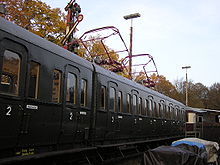DR 1589a / b to 1645a / b
| DR ELT 1589a / b to ELT 1645a / b | |
|---|---|
| Number: | 57 |
| Manufacturer: | Wismar , WUMAG , WASSEG , BBC |
| Year of construction (s): | 1924-1932 |
| Retirement: | 1955 |
| Axis formula : | Bo'2'2 ' |
| Genre : | BCPw 6 |
| Gauge : | 1435 mm ( standard gauge ) |
| Length: | approx. 28,800 mm |
| Service mass: | 66.3 t |
| Top speed: | 60 km / h |
| Traction power: | 300 kW |
| Impeller diameter: | 1000 mm |
| Power system : | Alternating current 6600 volts / 25 Hz |
| Power transmission: | Overhead line |
| Seats: | 105 |
The elT 1589a / b to elT 1645a / b were multiple units of the Deutsche Reichsbahn for overhead line operation with alternating current for the Hamburg-Altona urban and suburban railway, which had been electrically operated since 1907 .
construction
In 1924, 1927 and 1932, the Deutsche Reichsbahn delivered 57 two-car multiple units with the Bo'2'2 ' wheel arrangement. They each had a two-axle motor and two trailer bogies . The middle of these three bogies was a Jakobs bogie , on which the two closely coupled ends of the wagon were supported.
The car body was made in the then new steel construction with a barrel roof by the companies Wismar , WUMAG and WASSEG , the electrical equipment, however, by the BBC . The structure with doors on both sides for each seat compartment was derived from the Prussian compartment car . The seat compartments were equipped in one car according to the 2nd class at that time and in the other according to the 3rd class (wooden bench seats).
The current system of 6600 volts at a frequency of 25 Hertz, which was used as early as 1907, was taken over by the trial operation on the Schöneweide – Spindlersfeld branch near Berlin between 1903 and 1906. The maximum speed was 60 km / h.
Operational management
The vehicles were initially designated as Altona 641 a / b ff , from 1931 as 1589a / b to 1645a / b . A redesignation planned after 1940 to ET 99 001a / b to ET 99 052a / b based on the new direct current motor vehicle series ET 171 (see below) did not take place. A renewed start of the redrawing in 1950 was no longer realized because of the foreseeable shutdown of the AC operation at that time.
The AC multiple units were all located in the Hamburg-Ohlsdorf depot .
The urban and suburban railway, known as the “ Hamburg S-Bahn ” from 1934, was converted to direct current busbar operation based on the model of the Berlin S-Bahn from 1940 . Due to the economic restrictions in World War II , however, the AC vehicles continued to run together with the new ET-171 DC railcars with a mixed power supply with overhead lines and busbars . In 1955 AC operation was finally discontinued. Of the AC multiple units, only the ELT 1643 and ELT 1642 were converted for DC operation and converted into pure baggage trains. The numbering of these two trains was ET 174 001 and 002 , but they were also retired in the late 1960s and scrapped in 1967.
Whereabouts
After the end of AC operation, additional AC multiple units were converted into living and sleeping cars for construction trains and remained in the Deutsche Bundesbahn's portfolio until the mid-1970s .
The Association of Traffic Amateurs and Museum Railways (VVM) took over the former elT 1624a / b, which had been parked for scrapping, in 1974 and the former elT 1638a / b two years later. For the anniversary "150 years of the railways in Germany" in 1985, the elT 1624 was refurbished and restored to the delivery condition; the elT 1638 served as a spare parts dispenser. This is available in 2019 unrestored as a storage room and spare parts dispenser for the restored set. A work-up is not planned.
In 2007, the elT 1624 was again painstakingly restored for the exhibition “100 Years of Hamburg S-Bahn” in Ohlsdorf and was shown outside of its Aumühle location for the first time since 1985.
Individual evidence
- ^ Suburban railway 1638a / b. VVM , accessed December 18, 2018 .

